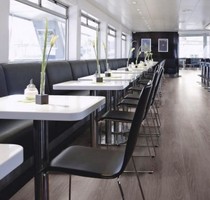Installation and maintenance instructions
1 General guidelines
For the best appearance and longest service life of Stride tiles, the subfloor should be as smooth and flat as possible. The sub-floor surface must be free from any contamination or chemical treatment that could affect the installation. Stride can be installed on most well-constructed solid or timber floors and are suitable for use with underfloor heating systems providing that the surface temperature does not exceed 27° C.
It is highly recommended that all subfloors are primed with a proprietary floor primer prior to installation. Ensure all boxes of tiles are the correct colour and from the same batch. Mix tiles from several boxes to achieve a good distribution of colour across the finished floor. Stride products are not suitable for outdoor use.
2 Subfloor conditions
2.1 Sub-floor suitability
Suitable substrates include concrete, sand-cement screed, flooring grade asphalt, floorboards, chipboard, ply-board, MDF and hardboard, but may require some preparation and smoothing before installing tiles. It is not advisable to cover the following as they may deteriorate or become unstable: parquet, wood block floors, laminates and floating engineered or solid wood.
2.2 Sub-floor preparation and smoothing
Stride are dry-back tiles and must be fully adhered to a smooth, hard, clean (free from dust and small particles) and permanently dry subfloor (incorporate a damp proof membrane where there is a solid subfloor.) In general, existing floor finishes and coverings should be removed. In particular loose-laid or floating finishes and soft finishes such as carpet or carpet tiles must be removed. Linoleum, PVC and other finishes may become loose if covered and cause the new floor installation to fail.
MOISTURE: In addition to a visual inspection ALL floors should be tested to ensure that they do not contain excessive moisture before installing Stride. For solid floors, BS 8203:2001 requires that a hygrometer test is made and the resulting moisture level reading is less than 75% R.H. at 20°C.
NB. Timber floors can also contain high levels of moisture as a result of water spillage, leaking pipes, floods, residual construction water, lack of ventilation or high air humidity either from above or below. It is highly recommended that all subfloors are primed with a proprietary floor primer prior to installation.
2.3 Solid floors
Direct-to-earth (ground level) solid floors must incorporate an effective damp-proof membrane and remain permanently dry at a level below 75% R.H. (as above). Suspended (above ground level) solid floors do not require a damp-proof membrane, but should have adequate ventilation below them and should also remain permanently dry, below 75% R.H.
Any existing floor-coverings should be removed together with residues of adhesive. If the surface is not smooth enough, a suitable floor smoothing screed should be applied at a nominal thickness of 3mm or more if the floor is very uneven.
Sufficient time must be allowed for screeds to dry out before the flooring is installed. In all cases the screed manufacturers recommendations regarding application and drying times should be followed carefully.
Alternatively, on dry floors and where appropriate, a floating sub-floor system such as Jumpax (Karndean Versilay, Estillon Linofloor or Smartfloor , Forbo Quickfit) may be used (in accordance with manufacturer's instructions) as a fast-track, dry-laid method to smooth and prepare the floor surface. Jumpax is also an excellent acoustic underlay system should this is be required on upper floor levels.
2.4 Timber floors
Suspended timber floors (joists and boards) must have adequate ventilation below them to disperse any moisture and prevent dry-rot. At ground level they must have at least 150mm well ventilated void space below and an effective damp-proof course at contact points with supporting walls. Boards should be in good condition and securely fixed to the joists.
Floating timber floors at ground level (chipboard on insulation slab on concrete base) must be dry and have an effective damp-proof membrane incorporated into the concrete base. The decking boards should be well supported from below by the insulation material and without excessive flexing movement under traffic. All board joints should be securely glued together.
Timber floors should be overlaid with a good quality exterior grade ply-board, minimum thickness 4mm, to provide a smooth, even surface and prevent floorboard joints from showing through as lines or ridges in the finished floor. Ply-board joints should be positioned so as not to coincide with floorboard joints and every sheet should be secured by annular nails or suitable divergent point flooring staples at minimum 150mm centres across the entire area. Nails or staples should finish flush or below the ply-board surface. Ply-board Stride joints and nail heads may require filling with a suitable feather-edge smoothing compound, which must be allowed to dry thoroughly before covering. Alternatively, or where acoustic insulation is required, Jumpax underlay may be used (in accordance with manufacturer's instructions) to smooth and prepare the floor surface.
3 Storage, site conditions and acclimatisation
Store all LVT products in their original packaging on a flat surface in dry conditions and away from direct heat sources.
An acclimatisation period of 24-48 hours in warm, dry conditions should be allowed prior to installation for the material to reach a uniform temperature close to the normal ambient room temperature expected in service. Ideally this is around 18° C. At low temperatures the material can become difficult to handle and cut.
Site conditions will affect the installation process and the future performance of the floor. The area should be dry, clean and remain at a steady temperature between 15- 25° C before, during and for a further 48 hours following the installation. Any underfloor heating system should be turned off 24 hours before commencing the installation and remain so until 48 hours after completion and then be gradually brought back up to normal operating temperatures.
4 Adhesives
The correct adhesive to be used will depend on the expected service conditions for the floor.
Adhesives must be used in accordance with the recommendations on the container.
Coverage will vary depending on the smoothness of the subfloor and the size of trowel notch used.
5 Installation
Spread the appropriate recommended adhesive onto the subfloor using a suitable notched spreading trowel. Press the planks well into the adhesive to avoid air being trapped between the planks and the subfloor. After installing the floor it is advised not to walk on it for at least 24 hours.
6 Instructions for use
To keep your floor in good condition, it is important to place doormats at all entrances to eliminate abrasive particles driven by footwear (gravel, pebbles, ...). Use felt protector pads under the feet of furniture items or under other heavy objects. Do not use rubber carpets. Use soft, non-rubber wheels for office chairs.
7 Maintenance Guide
General maintenance - The amount of daily usage will determine how often cleaning is required. Sweep as necessary with a soft broom. Care must be taken if you use a vacuum cleaner, do not use vacuum cleaners with “beater bars”.
Wipe over with a clean damp mop or cloth, which should be rinsed frequently in clean water. (Remember that all floors can be slippery when wet.)
When necessary wash with a solution of clean water and mild detergent or domestic floor cleaning emulsion*.
Rinse thoroughly and soak up residual water.
For additional lustre buff with a dry cloth. Spots, marks and spillages should be wiped up as soon as possible.
7.1 *Do not use:
- Wire or nylon wool scouring pads
- Furniture polish
- Spirit based polish
- Powder or liquid abrasive cleaners
- Bleach or strong detergents
7.2 Protecting your floor from physical damage
Avoid the following:
- Scuff damage can result from dragging heavy appliances across the floor. This can be avoided by placing a sheet of hardboard or an off-cut of carpet beneath such units before repositioning them.
- Hot or burning objects may scorch or blister the surface of the floor.
- Abrasion from grit can be prevented by placing a doormat by external doorways. This will also reduce unnecessary cleaning. The doormat must be constructed from a non-staining material (see below)
7.3 Protecting your floor from stain damage
Avoid the following:
- Rubber backing on doormats may result in yellow discolouration of the floor immediately beneath. Choose a natural fibre mat in preference.
- Rubber feet on furniture may cause staining. Remove them altogether or place coasters or felt pads between them and the floor.
- Spirit-based products such as shoe polish, solvents, hair dye and permanent marker pens. Wipe up spots and marks as quickly as possible. Also applies to turmeric, mustard and strongly coloured foodstuffs.
- Corrosive substances such as acid and alkaline solutions can damage the surface of the floor, clean up any spills quickly and carefully avoiding direct with the substance. Wear protective clothing (gloves etc. when doing so)
- Bitumen/tar from freshly resurfaced or melted roads and pathways. Some inexpensive rubber shoe (and slipper) soles can also cause stains
The above list is indicative of materials likely to cause damage but is not to be considered restrictive.




